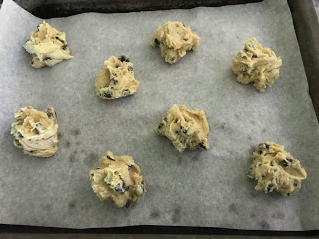I make a large batch of rosemary lentils at the beginning of the week and have them cold for my lunches all week long. On top of that, I also occasionally make them for my family for dinner. I mentioned this dish the other day in a post and was requested more information. It makes a great summer dish -- it's easy, fresh, and can be made in the morning (while the house is still cool) and served in the evening.
Rosemary Lentils (serves 4)
3 cups water
20 4-inch springs fresh rosemary (should yield about 1/3 cup minced), more if you really like rosemary -- up to 30 sprigs or 1/2 cup minced
1 large clove garlic minced, or 1/2 teaspoon garlic powder
1/3 teaspoon salt
dash black pepper
1/4 cup olive oil
Place rinsed lentils and water in a medium saucepan. Bring to a boil. Reduce heat, cover. Simmer for 25 to 30 minutes, until soft but hold their shape. Drain off any excess water. Rinse gently and drain again.
While lentils cook, strip the leaves off of the rosemary stems, leaving the tender top inch of each stem with the leaves. Discard the long stems. Chop leaves fine.
In a large bowl, toss the cooked lentils with chopped rosemary, garlic, salt, pepper, olive oil, lemon juice, and vinegar. Adjust seasonings.
Serve warm or cold over salad greens or as a sandwich stuffed in pocket bread.
notes on the recipe
My family loves the flavor of rosemary, so I use the greater amount (30 springs). I don't think it's too heavy at all. However, if you're unsure how much rosemary you might like, try the lesser amount to start, toss with lentils, then add more if you want at that point. With the salt, if you normally eat less salt, try 1/4 teaspoon to begin, then add a sprinkle more if you think you'd enjoy more salt. You could use vegetable oil, but I do think that olive oil really adds to the overall flavor. I buy olive oil in large, restaurant supply jugs. I keep most of it in its original jug in the refrigerator, keeping a month's worth in a small, dark glass bottle in the pantry for convenience. I've been using this same large jug of olive oil for almost two years. I'm at the bottom of the jug and the flavor is still very good. Olive oil deteriorates when exposed to light or prolonged warmth. So I believe that storing the bulk of it in the fridge has been beneficial for the oil.
health benefits of rosemary
I love the flavor of rosemary. But I also love the health benefits.
- Rosemary is believed to slow cancer cell growth and possibly inhibit tumor formation.
- Rosemary may boost the immune system. The acids in rosemary work as antibacterial, anti-fungal, and antiviral agents.
- Rosemary also has anti-inflammatory properties and may help reduce some chronic pain, such as with RA.



















































